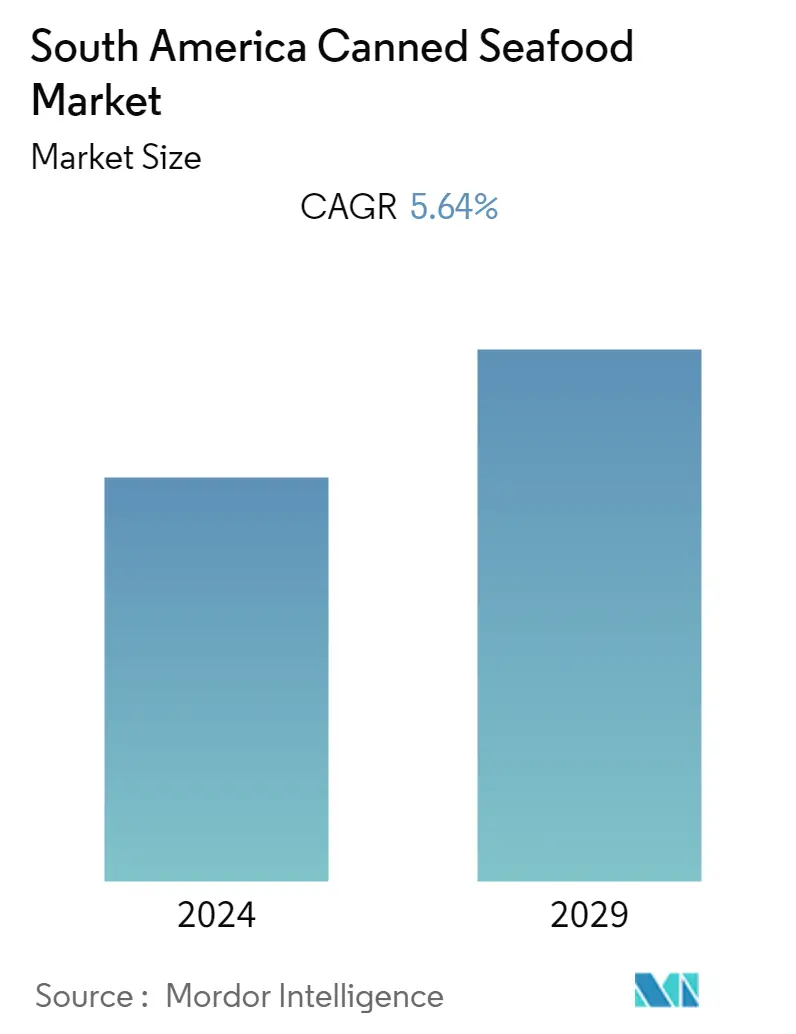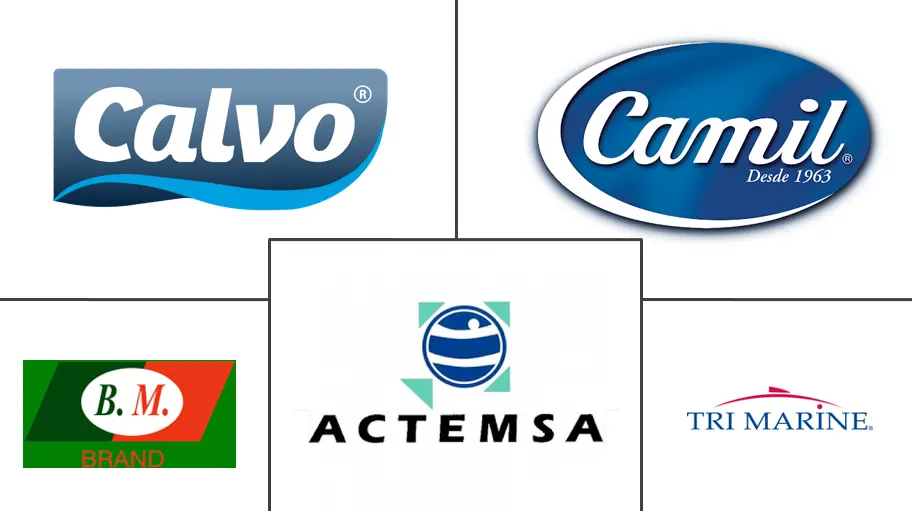Market Size of South America Canned Seafood Industry

| Study Period | 2019 - 2029 |
| Base Year For Estimation | 2023 |
| Forecast Data Period | 2024 - 2029 |
| Historical Data Period | 2019 - 2022 |
| CAGR | 5.64 % |
| Market Concentration | High |
Major Players
*Disclaimer: Major Players sorted in no particular order |
South America Canned Seafood Market Analysis
South America canned seafood market is expected to grow with a CAGR of 5.64 % during the forecast period (2020 - 2025).
- The South American market is expected to be witness a significant demand for canned seafood in the near future owing to the rising health concerns regarding the ill-effects of excessive consumption of red meat. The people of the country are turning to seafood for fulfilling their protein requirements.
- This is supported by the fact that access to diagnosis in the region is restricted and access to care is highly variable, particularly in regard to urban vs. rural settings, which is making the population shift more toward healthy eating, thus driving the growth of canned seafood products in the market.
- Vast opportunities for canned seafood are hence, anticipated to exist in the region as brands are compelled to meet consumer demands for clean, simple, and safe products.
- Brazil accounted for the largest share of the market for canned seafood products in South America as the growing middle-class population has fueled a change in the traditional buying pattern.
South America Canned Seafood Industry Segmentation
The South America canned seafood market is segmented by product type into canned fish, canned shrimp, and other canned fish. The canned fish segment is further divided into tuna, salmon, and other canned fish types. Based on the distribution channel, the market is segmented into supermarkets/hypermarkets, convenience stores, online retail stores, and other distribution channels. The market is also classified by geography into Brazil, Chile, and Rest of South America.
| By Product Type | |||||
| |||||
| Canned Shrimp | |||||
| Other Canned Fish |
| By Distribution Channel | |
| Supermarkets/Hypermarkets | |
| Convenience Stores | |
| Online Retail Stores | |
| Other Distribution Channels |
| Geography | |
| Brazil | |
| Chile | |
| Rest of South America |
South America Canned Seafood Market Size Summary
The South American canned seafood market is poised for substantial growth, driven by a shift in consumer preferences towards healthier protein sources, particularly seafood, due to rising health concerns associated with red meat consumption. This trend is further amplified by the region's variable access to healthcare, which encourages healthier eating habits. As a result, there is a burgeoning demand for canned seafood products, presenting significant opportunities for brands to cater to consumer desires for clean and safe food options. Brazil, as the largest market in the region, is experiencing a transformation in buying patterns, fueled by its expanding middle class. Despite its potential as an aquaculture leader, Brazil's reliance on imports persists, with countries like Chile and Ecuador playing crucial roles in supplying canned seafood to regional markets.
The Brazilian market's growth is supported by increasing disposable incomes and strategic investments in fishery production, alongside efforts to enhance distribution channels in remote areas. Global companies are focusing on expanding their presence in emerging economies within the region, capitalizing on rising income levels and a growing awareness of healthy eating. Regional private-label brands are gaining traction due to consumer preference for cost-effective options. This geographical expansion strategy is vital for establishing a broad consumer base, with key players like Grupo Calvo, Grupo Camil, and Tri Marine Group actively participating in the market's development.
South America Canned Seafood Market Size - Table of Contents
-
1. MARKET DYNAMICS
-
1.1 Market Drivers
-
1.2 Market Restraints
-
1.3 Porter's Five Forces Analysis
-
1.3.1 Threat of New Entrants
-
1.3.2 Bargaining Power of Buyers/Consumers
-
1.3.3 Bargaining Power of Suppliers
-
1.3.4 Threat of Substitute Products
-
1.3.5 Intensity of Competitive Rivalry
-
-
-
2. MARKET SEGMENTATION
-
2.1 By Product Type
-
2.1.1 Canned Fish
-
2.1.1.1 Tuna
-
2.1.1.2 Salmon
-
2.1.1.3 Other Canned Fish
-
-
2.1.2 Canned Shrimp
-
2.1.3 Other Canned Fish
-
-
2.2 By Distribution Channel
-
2.2.1 Supermarkets/Hypermarkets
-
2.2.2 Convenience Stores
-
2.2.3 Online Retail Stores
-
2.2.4 Other Distribution Channels
-
-
2.3 Geography
-
2.3.1 Brazil
-
2.3.2 Chile
-
2.3.3 Rest of South America
-
-
South America Canned Seafood Market Size FAQs
What is the current South America Canned Seafood Market size?
The South America Canned Seafood Market is projected to register a CAGR of 5.64% during the forecast period (2024-2029)
Who are the key players in South America Canned Seafood Market?
Grupo Calvo, Grupo Camil, Beira Mar Importers Co Ltd, Tri Marine Group and Leal Santos are the major companies operating in the South America Canned Seafood Market.

